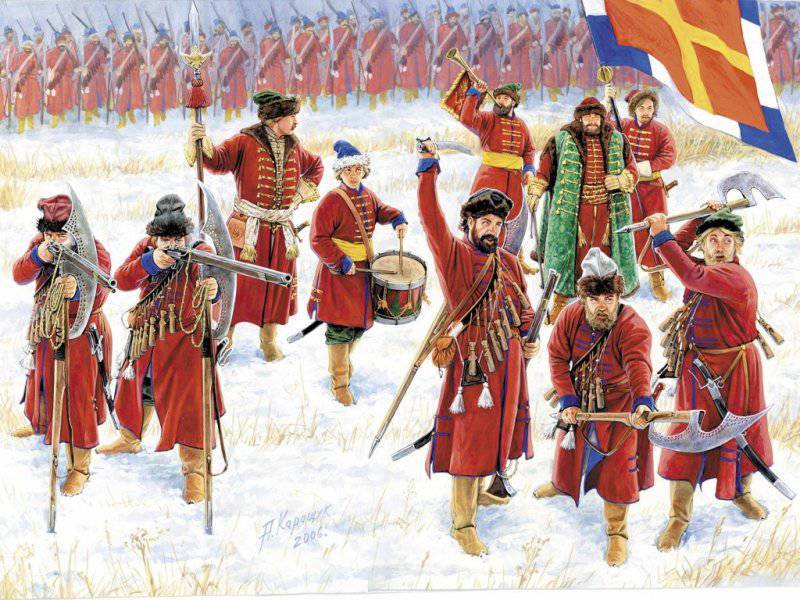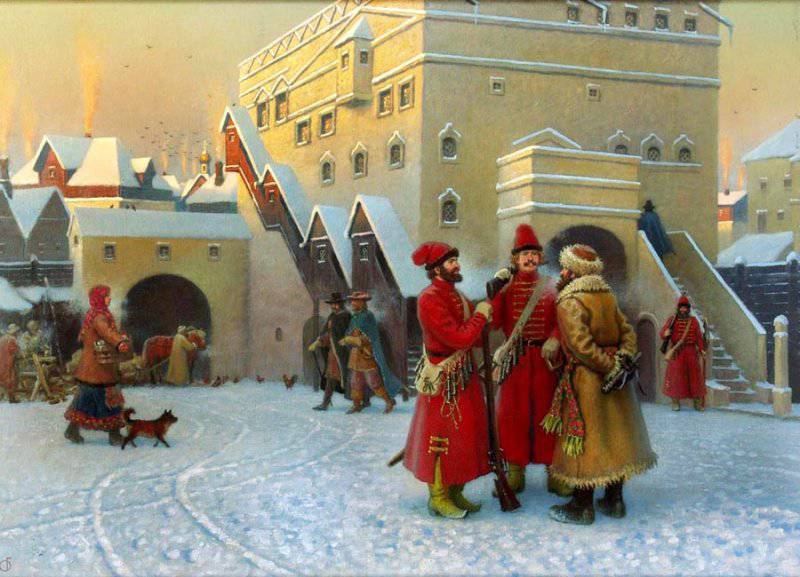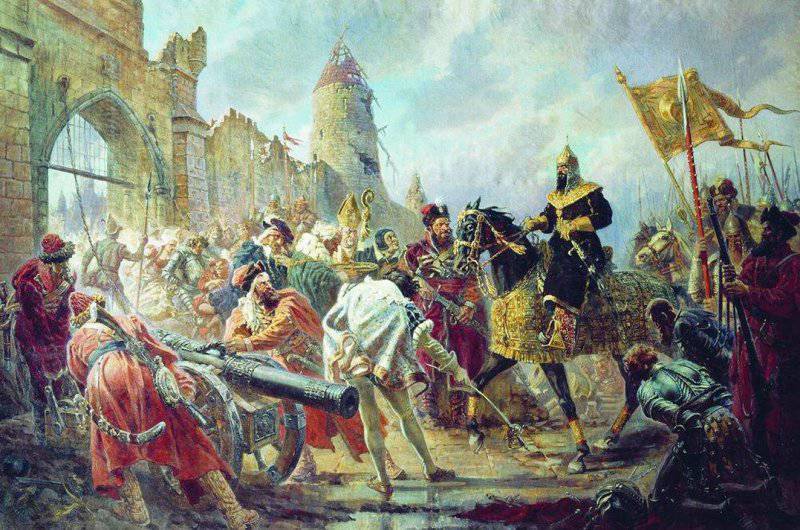The birth of the regular Russian troops
All people are created for peace and friendship, however, unfortunately, since they appeared on earth, hostility has constantly arisen between them.
Cavemen were squabbling among themselves one by one, but as the number of Homo sapiens increased on the planet, the hostility became more serious - entire families, communities began to fight, and the peoples turned against each other. In the end, it came to the point that virtually all disputes between countries were resolved only by force. Accordingly, the wealth and prosperity of each state began to depend on how well it was able to defend itself against enemies. However, the time of the enemy's attack was often impossible to determine; the only way out was to have ready a certain force, which was necessary both to repel an unexpected attack of the enemy and for an equally unexpected attack on him. And so a certain part of the people, called an army, appeared in every state. The army could be good or bad, and its strength was not so much dependent on the number of warriors as on their habits and ability to win. There are many examples of how in ancient times, even before the invention of firearms weapons, the small detachments of professional military utterly smashed huge hordes of inept foes. The only way to improve the skills of the troops was the need for constant, even in peacetime, training in the art of war.
More than a thousand years ago, the Russian land, divided into small principalities, did not have a permanent army. All that was was the infantry people's militia, which gathered only in case of war. All the inhabitants of cities and villages of the male who were capable of carrying weapons went into this militia. The youngest sons remained in the houses to protect the farm. As soon as the war ended, the army ceased to exist, and all the fighters were sent home. The princes resorted to such a set in the event that the foes were strong and threatened the entire Russian state. If the army required a small one, then a decree was issued, commanding that a man should assemble from a certain number of “soh” or “smokes”. It is worth noting that in addition to the people's militia for the defense of the Fatherland were also voluntary "eager" people. They were on foot and fought, as a rule, because of one greed for profit. The princes hired cavalry from the nomadic peoples, who were also attracted by mining. Even when the princes were their own squads. Vigilantes - the guards of that time - always went to battle ahead, and in peacetime protected the sacred person of the Grand Duke. Combined troops commanded the boyars. For their deeds, they were rewarded with estates, from which they were obliged to supply a certain number of warriors "in a soshno" or "in a smoky manner". Of course, such armed forces of the country did not at all resemble modern regular troops. Rather, it was a crowd of people, fighting, than horrible and how horrible. Such troops were in Russia for almost six hundred years, up to the 1462 year, when Tsar Ivan III united the isolated principalities into one Moscow state, becoming the sovereign of the Russian land. The same period of time was marked by the first weighty victory of our united army led by Dmitry Donskoy on the Kulikovo field.
As soon as Russia became one large state headed by one Tsar, new orders began. The tsar began to give land to those landowners who served at their own will. Despite the fact that the service was obliged to come with his horse, weapons and gunpowder, from those who wanted to receive the land there was no end. And although even before Ivan III, the boyars were provided with land from the treasury, for which they were obliged, in turn, to supply soldiers, it was from Tsar Ivan the Great that such a recruitment of people to the troops became ordinary. And each landowner, supplying a certain number of their armed people during the campaign, had to maintain them at his own expense. Such troops were called local, except for them in Russia at that time they equipped dutch ones - for a person from a certain number of yards. However, both the local troops and the militia gathered only in case of the start of the war, which means that they could not be considered permanent.
The first relatively regular "troops" appear in Russia in the reign of Ivan the Terrible. The desire of Ivan Vasilyevich to create a permanent combat-ready squad was dictated by a number of problems in the state and was quite timely. The decree adopted by the king in the 1550 year is noteworthy because it was not just ordinary people who were subject to "surrender". The chosen thousand consisted of representatives of the most distinguished boyar, noble and princely families experienced in the art of expropriation, ready to stand up for their native land at any time. In order to ensure a quick response of the “thousanders” in the event of a sudden danger, it was decided to distribute the estates to their families in areas adjacent to the capital. The size of the allocated land was determined by the article to which this or that boyar belonged, and ranged from one hundred to two hundred quarters. All data on the persons to be called up for service, and the estates distributed to them were recorded in a special “Thousand Book”.
In the same year another important event occurred. Ivan the Terrible organized a unique compound - a constant Streltsky army, which was charged with the duty to protect the sovereign and his Moscow court, pacify insurrections inside the country, and most importantly, be the first to come forward to meet the enemy, while the local army is about to assemble. Initially, six regiments (articles) of archers with five hundred people each were created. They commanded the archery detachments of the head, appointed from the boyar children. Of the boyar children were centurions. The newly-quartered troops quartered in the Vorobieva settlement near old Moscow, and they were appointed a salary of four rubles a year. Heads and centurions received more local salaries.
About archers should be said separately. They were housed in houses built for them by the government, and received from him a salary, uniforms and weapons. For this they were obliged to serve all their lives, and after the death of his father his eldest son occupied the regiment. To control the archers in 1555, Streletsky hut was established, renamed Streletsky order later. Food and cash came to the bins of the Streletsky order from various departments, in the subordination of which were the black-nosy peasantry and the burdened population of the cities. The first baptism of fire the archers took during the storming of Kazan in the 1552 year, and later were obligatory participants of all military campaigns. In peacetime, Moscow archers served as firefighters and police officers.
The measures taken by Ivan the Terrible made it possible not only to provide the capital and the approaches to it with combat-ready troops ready for rapid deployment, but also to partially solve one of the most problematic key political issues of the mid-sixteenth century - the issue of providing land for the nobility. As a result of the implementation of the above-mentioned verdict “On the use of service people”, “thousanders” took possession of more than one hundred thousand quarters of fertile land. By the 1552 year, the so-called Palace Notebook was compiled, in which all the representatives of the sovereign's court were recorded in their districts, from which the highest command cadres for the army and the state were elected, that is, the governors and heads.
1. Archers, who form the basis of the infantry. In addition to what has been said about them, it should be added that over the years since the time of Ivan the Terrible, the streltsy detachments have greatly degraded. In peacetime, they preferred to engage in trade and fishing, becoming more urban and rural inhabitants than warriors. All their free time they were engaged in their economic affairs, they paid very little attention to the military craft, they did not know discipline as such, often being participants in various riots and uprisings.
2. Foot and equestrian city Cossacks serving for the land given to them by the state. They belonged to the local troops and gathered only for the duration of the war.
3. Temporary militias, which were represented by nobles who owned estates, and boyar children, along with their servants and peasants. The militia appeared, like the Cossacks, at the royal call in case of war, making up the main cavalry of that period.
4. Foreign troops, consisting of foreigners who take up employment for hire in whole detachments. Of course, such troops, by definition, could not be good. Each stranger thought only about his own benefits, serving a foreign country was not to his liking.
One of the main goals of his activity, Ioann Vasilyevich, considered the further strengthening of the centralized Russian state, knowing full well that only being united and cohesive from the inside would it be able to repel an external enemy. In addition, the existing feudal fragmentation, in which every landowner “rooted” only for his patrimony, placing his own interests above the state, significantly hampered the economic and cultural growth of the country as a whole. An organized, larger, better armed army was also necessary for the expansion of Russian territories in order to gain trade opportunities with overseas countries and the states of Central Asia. And after the introduction of the oprichnina in 1564, the king’s loyal troops helped to effectively deal not only with the dispersed arbitrariness of the boyars, but also to restrain the onslaught of external enemies eager to tear pieces off the Russian land. And in the 1570 year, with the support of his glorious army, Ivan IV defeated Novgorod, the main stronghold of Westernism and separatism, injected by the specific principalities in spite of the sovereign's desire for internal unity and independence.
Ivan the Terrible, undoubtedly, one of the most famous and controversial Russian tsars. His vivid and memorable image is so firmly entered into the historical memory of a domestic citizen that it is already difficult to figure out where the truth ends and political propaganda begins, as well as the imagination of writers, directors and artists of different eras. And was it true? The king, according to historians' studies, was so fond of putting the main political decisions in the form of a game or a farce, which, obviously, he himself lost the concept of the boundary between life and perception. With his impetuous desire to centralize power, the king made many enemies among the feudal aristocracy, who relied on the very impressive economic base of his households and did not want to part with his privileges.
However, all this does not detract from the huge role of Ivan IV in the history of our country. It was with him that Russia from a conglomerate of scattered feudal principalities, regularly subjected to plunder and ruin, finally turned into a single centralized state, which took an honorable place among the major European powers and has a formidable Army, ready to give a fitting rebuff to everyone who encroaches on its holy land.
Information sources:
http://adjudant.ru/petr/yanush01.htm
http://www.opoccuu.com/011011.htm
http://nvo.ng.ru/history/2001-07-20/5_army.html
http://vpk-news.ru/articles/848



Information